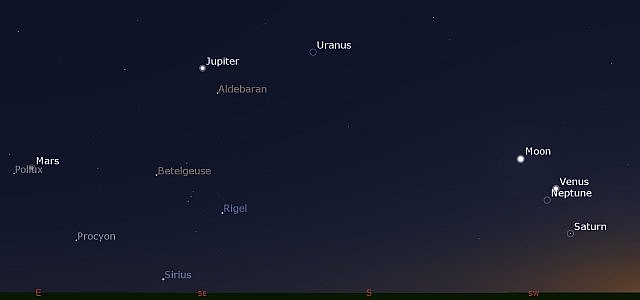
Occasions when several planets are visible in the night sky at the same time without being close together are not exactly common but do happen frequently enough to make them worth looking out for. There was such a "Parade" at the end of 2024 and the begining of 2025, with all the planets except Mercury being easily visible in the night sky at the same time for several weeks. And by "easily visible" I mean able to be seen at a reasonable altitude against a dark sky - possibly only with optical aid though. I thus felt I ought to capture images of each of them, just for the record if for no other reason. Doing so for Neptune wasn't really possible though as by the time my weather conditions improved sufficiently to give me some clear skies it was quite low down in the west and thus beginning to get lost in the twilight. The image below shows how the astronomy program Stellarium saw the Parade, looking South when I took my pictures (just after sunset on 2nd February).

The production of this chart, and the others shown below, was not a straightforward process so those interested in this sort of thing might like to click here to see how it was done.
The device below enables you to step across the sky from East to West to see (in turn) the pictures I took of Mars, Jupiter, Jupiter plus Uranus (with a locator for Uranus next), and then the Moon plus Venus & Saturn. Were it to be visible, Neptune would have been seen slightly to the lower left of Venus - as shown by the final frame.
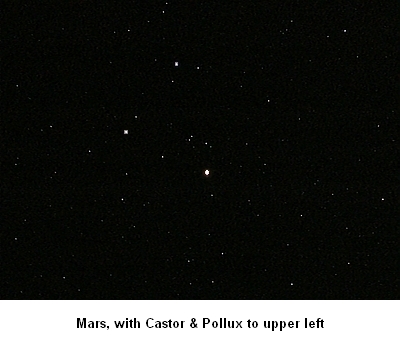 |
And if you had looked up a couple of days after I took the above images what you would have seen is shown by this excellent panorama produced by my school-chum and "astro-collaborator" Roger Firth:-
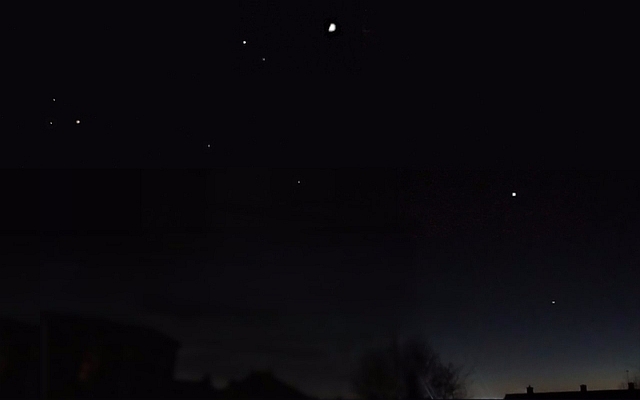
Image (c) Roger Firth 2025
Here we see, stretched across the sky from East to West (left to right), Mars plus Castor & Pollux; Jupiter and Aldebaran; the Moon; Venus, and finally Saturn sinking into the twilight. The other two stars visible are Betelgeuse (upper) and Rigel (lower) in the constellation of Orion. The very bright star Sirius and also Procyon nearby would have been seen to lower left were it not for an annoying cloud bank blocking the view. It can be seen that the Moon has moved much higher in the sky in the time between our observations.
Mercury, well below the horizon in the Stellarium view above, moved to the east of the Sun and joined the Parade at the end of February. Both it and Saturn were very low in the west though (only 4 degrees above the horizon 40 minutes after sunset on the 25th) so it, and particularly Saturn at just magnitude +1, were only visible under excellent viewing conditions. I did have a look, but soon realised it was a hopeless task because of the excessive sky brightness that close to sunset.
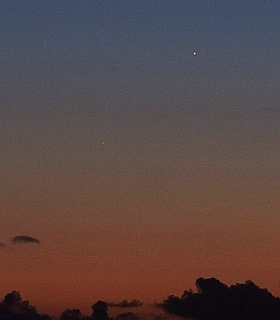 | There was however one observation from the 25th recorded on the website of the British Astronomical Association, shown here on the left. Mercury is clearly visible, but can you see Saturn? It's just to the upper left of centre, but quite faint. Well done James! At this point all seven planets were above the horizon at the same time, though not all of them were actually visible. Uranus & Neptune are inherently too faint to be seen against other than a dark sky and of course, as illustrated here, the visibility of Saturn was decidedly marginal. | |
| Image (c) James Weightman 2025 |
| Due to a combination of being out during the evening on the 25th & 26th and cloud on the 27th I was only able to begin my observations on the 28th, when I managed to capture Mercury at about 6:20pm when it was a little over 5 degrees high - see image on the right. In fact, looking back over enhanced versions of my images later I found I had probably caught it at 6:10 but didn't realise I had because the camera was pointing a little too far to the south and so the potential target had only just sneaked into the top right corner. | 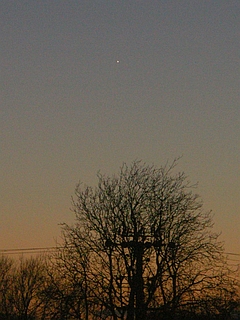 |
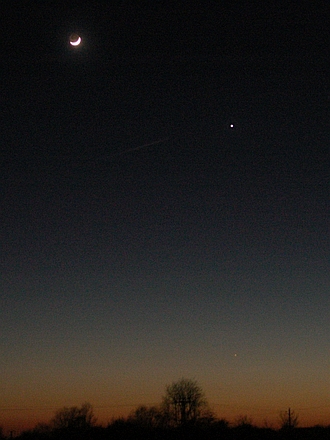 | Conditions for the first week of March looked hopeful, but low cloud in just the wrong place rather spoiled my attempts on the 1st. Skies were crystal clear on the 2nd though, enabling me to capture the crescent Moon with Earthshine, Venus and Mercury (to the upper right of the same tree as above), as shown here. |
Venus had reached its highest elevation above the horizon in mid-February and so during the early days of March it was rapidly dropping towards the horizon while Mercury was rising. The two thus converged in the sky, reaching their closest separation of 5.5 degrees on the 12th. I was out that evening but was blessed with unexpectedly clear skies on the 13th, when the separation was only fractionally greater. I was able to pick up Mercury in binoculars at about 6:35pm, and observe it visually from 6:40pm. I thus followed the pair down to the horizon and captured the image below at 7pm as they began to set in the deep dusk.
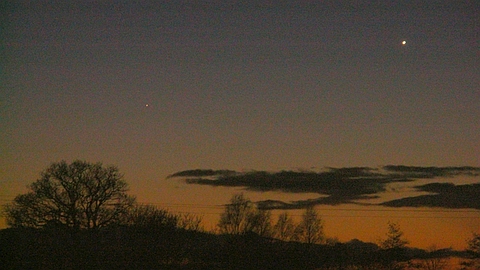
And that was about it really, as Saturn had become unobservable at the end of February, Neptune followed in early March and the two inner planets were now rapidly heading for the horizon. Jupiter & Mars were both still high in the sky, with Uranus visible with optical aid, but the grand evening show was over.
![]()
However, for those who like to rise with the lark (or even before!), there will in fact be a further chance to see a Parade in 2025. The Stellarium chart below shows the skies an hour before dawn (that is about 5am BST!) on 25th August, with 6 planets above the horizon. This Parade is not a particularly spectacular one though as Saturn will be quite distant from the other planets, and of course Uranus & Neptune will not actually be visible. Additionally, you might have to look carefully to see Mercury at just 5 degrees elevation but it will be at magnitude -0.74 so should be able to be seen in binoculars at least.
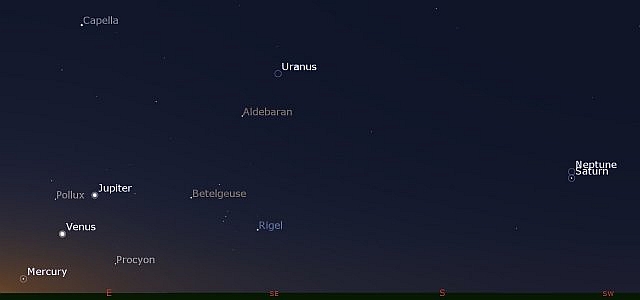
And as to when the next Parade after 2025 might be visible, that's actually a difficult question to answer as it depends on how many and which planets you expect to see, across how great a span of sky, and during which part of the night. It is relatively straightforward to search for actual conjunctions i.e. when the planets are really close together, but difficult to look for occasions when several are visible but spread across the sky. However, for those of you who like to get up early, the Internet tells us that in mid-October 2028 the planets Jupiter, Mercury, Venus, Mars, Uranus & Saturn will all be above the horizon around dawn, in that order, from East to West with the Moon also present from the 15th until the 18th. How many of the planets will actually be visible is, of course, another matter. Jupiter rises only 70 minutes or so before the Sun during this period and so at sunrise on the 16th, for example, it will sit at just a little over 10 degrees above the bright eastern (dawn) horizon. Similarly, Mercury will only be 15.5 degrees high. Both planets could thus be very difficult to see even at magnitudes -1.67 and -0.32 respectively and of course will be lower in the sky when seen against a somewhat darker sky before sunrise. Probably worth marking your diaries though, as you will have a few days to capture the lineup.
The view of the situation as seen by Stellarium on a typical viewing opportunity during this period (an hour before dawn on October 23rd) is shown below. As noted above, you might have to look carefully to see Mercury at 6 degrees elevation and magnitude -0.84 but its proximity to Jupiter at magnitude -1.68 will probably help find them both.
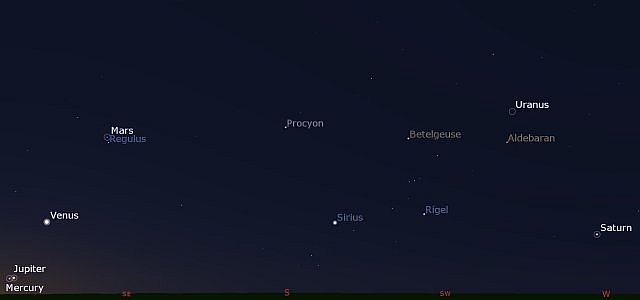
The next opportunities arise in early 2034. The Stellarium chart below shows the sky an hour after sunset on 28th January, when 6 planets plus the Moon will be above the horizon. Again, Mercury is quite low down and not all that bright against a dusk sky (6 degrees high at magnitude -0.34) so might have to be searched for; Mars is only at magnitude 0.95, and Saturn is a bit distant once more but at least it is a Parade!
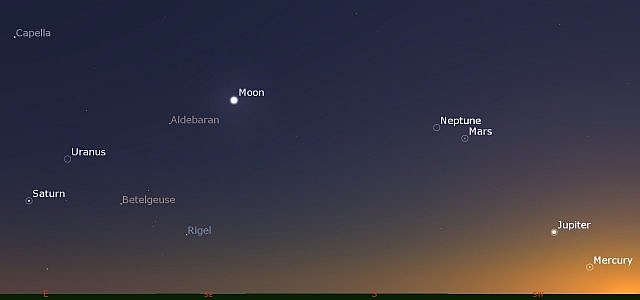
There is then a further opportunity late in February 2034 when at sunset Mercury is exchanged for Venus and so 6 planets plus the Moon will once more be (theoretically!) visible in the sky at the same time. In fact it's the same set as for February 2025 but not in the same order. The big problem on this occasion is that both Jupiter & Venus will be sitting incredibly low down in the twilight sky. The saving grace could be that they are also both very bright and just half a degree apart so at magnitudes -2.04 and -3.90 respectively it should be possible to spot them higher in the sky earlier in the evening even though the other planets in the Parade will definitely not be visible then. The Stellarium view of the situation about 50 minutes after sunset on 20th February is shown below, illustrating the difficulty in seeing Jupiter & Venus and the importance of them being so close together and thus shining out more brightly than either of them individually.
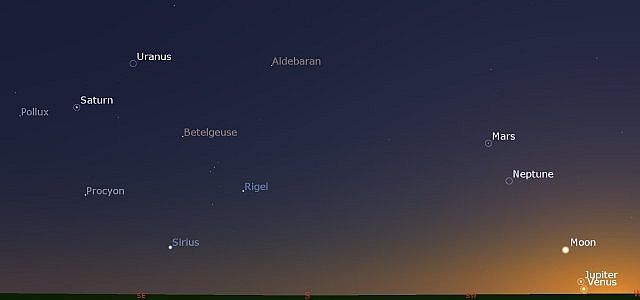
While none of the Parade opportunities given above will be easy to see, particularly as compared to the event in early 2025, given the hype surrounding that Parade the easiest option might be to simply keep an eye on the media - I'm sure they won't let a good story go unreported!